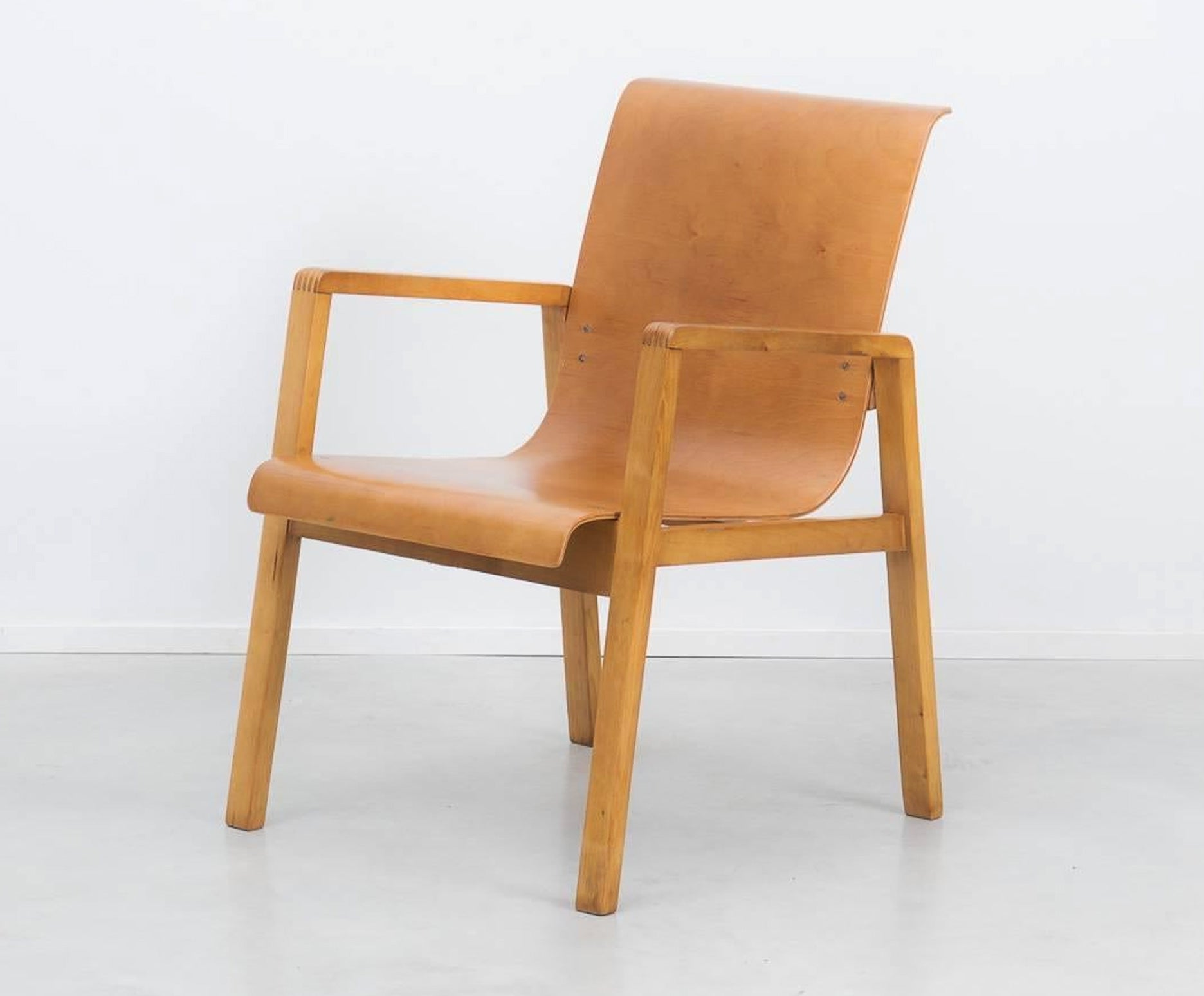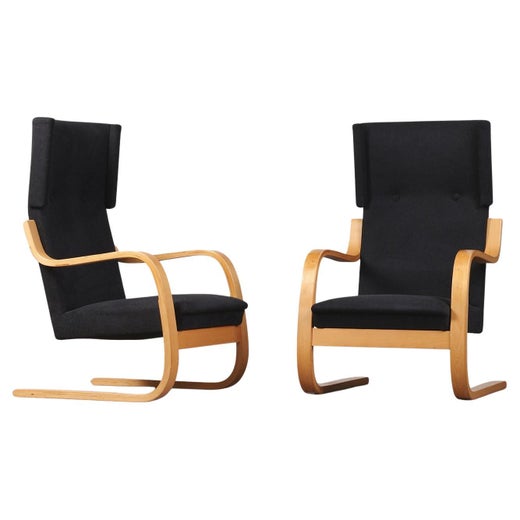Vintage Model 403 Hallway Chair by Alvar Aalto for Artek, Set of 2
About the Item
- Creator:Alvar Aalto (Designer)
- Design:
- Dimensions:Height: 30.32 in (77 cm)Width: 24.41 in (62 cm)Depth: 21.26 in (54 cm)Seat Height: 14.18 in (36 cm)
- Sold As:Set of 2
- Style:Mid-Century Modern (Of the Period)
- Materials and Techniques:
- Place of Origin:
- Period:
- Date of Manufacture:1932-1940
- Condition:Refinished. Wear consistent with age and use. The original white finish of the bent veneer seats had been refreshed, leaving the backrest and seat screws slightly less visible. The finger-joint detail of the armrests is intact and visible.
- Seller Location:Cape Town, ZA
- Reference Number:1stDibs: LU6897228992012
Hallway Armchair
A classic modernist masterpiece conceived by Finnish architects and designers Alvar and Aino Aalto (1898–1976; 1894–1949) in 1932, the Hallway armchair is lightweight, slender and perhaps above all, comfortable.
While it has since been coveted by collectors for use in nearly any room in the house, the chair was originally part of the furnishings for the Paimio Sanatorium — a facility that treated tuberculosis patients, tucked away in a dense pine forest in the rural Finnish city of Paimio.
The Aaltos secured the commission to design the sanatorium as well as its furniture, washbasins, clocks and more as a result of winning an architecture competition. Like the other designs on the sanatorium grounds, the Hallway chair’s most prominent attributes — its sturdy simplicity and easily stackable frame — represent Alvar Aalto’s pursuit of humanizing objects through the optimization of both form and function.
Although the couple had no previous experience in designing a hospital, the Aaltos were careful to select colors and materials that would play a role in establishing a comforting, healing environment but also serve specific purposes. The Hallway armchair’s frame is made of solid birchwood, a material favored by Finnish designers, and the seat shell is pressed birch veneer finished with clear lacquer. Its lacquer coating was chosen for its hygienic quality, as it could be easily wiped clean — an essential quality in any hospital, but in the case of battling a very contagious respiratory disease, such considerations were critical.
From light fixtures and colors of the balcony rails to the innovative and sculptural Paimio armchair, the Aaltos’ work at the facility aligned with Alvar’s principle of functionalism, which has now come to be known as “organic modernism.” He concerned himself with the relationship between design and the physical and cultural landscape it occupied. The sanatorium’s furniture was warm and unadorned, and the space itself offered a wealth of common areas and welcomed copious sunlight (early TB treatment prioritized fresh air and sunshine).
The Hallway chair was manufactured by Finmar and garnered acclaim and attention around the world, with the Museum of Modern Art featuring it in a show titled “Alvar Aalto: Architecture and Furniture” in 1938.
Alvar Aalto
An architect and designer, Alvar Aalto deserves an immense share of the credit for bringing Scandinavian modernism and Nordic design to a prominent place in the global arena. In both his buildings and his vintage furniture — which ranges from chairs, stools, tables and lighting to table- and glassware — Aalto’s sensitivity to the natural world and to organic forms and materials tempered the hardness of rationalist design.
Relatively few Aalto buildings exist outside Finland. (Just four exist in the United States, and only one — the sinuous 1945 Baker House dormitory at M.I.T. — is easily visited.) International attention came to Aalto, whose surname translates to English as “wave,” primarily through his furnishings.
Instead of the tubular metal framing favored by the Bauhaus designers and Le Corbusier, Aalto insisted on wood. His aesthetic is best represented by the Paimio armchair, developed with his wife, Aino Aalto, in 1930 as part of the overall design of a Finnish tuberculosis sanatorium.
Comfortable, yet light enough to be easily moved by patients, the Paimio chair’s frame is composed of two laminated birch loops; the seat and back are formed from a single sheet of plywood that scrolls under the headrest and beneath the knees, creating a sort of pillow effect. Aalto’s use of plywood had an enormous influence on Charles and Ray Eames, Arne Jacobsen, Marcel Breuer and others who later came to the material.
Concerned with keeping up standards of quality in the production of his designs, Aalto formed the still-extant company Artek in 1935, along with Aino, whose glass designs were made by the firm. In the latter medium, in 1936 the Aaltos together created the iconic, undulating Savoy vase, so-called for the luxe Helsinki restaurant for which the piece was designed.
Artek also produced Aalto pendants and other lighting designs, many of which — such as the Angel’s Wing floor lamp and the Beehive pendant — incorporate a signature Aalto detail: shades made of concentric enameled-metal rings graduated down in diameter. The effect of the technique is essential Alvar Aalto: at once precise, simple, and somehow poetic.
Find a collection of vintage Alvar Aalto stools, vases, dining tables and other furniture on 1stDibs.
You May Also Like
Mid-20th Century Finnish Mid-Century Modern Armchairs
Plywood
Vintage 1950s Finnish Mid-Century Modern Armchairs
Birch
Vintage 1940s Finnish Scandinavian Modern Armchairs
Birch
Vintage 1930s Finnish Scandinavian Modern Armchairs
Birch
Mid-20th Century Finnish Mid-Century Modern Chairs
Birch, Plywood
Vintage 1940s Finnish Modern Club Chairs
Fabric, Birch
Vintage 1950s Finnish Scandinavian Modern Armchairs
Leather, Wood, Birch, Lacquer
Vintage 1950s Finnish Scandinavian Modern Armchairs
Leather, Wood, Birch, Lacquer
Vintage 1970s Finnish Modern Armchairs
Fabric, Beech
Vintage 1950s Finnish Scandinavian Modern Armchairs
Leather, Wood, Birch, Lacquer
Recently Viewed
View AllRead More
The Very Modern Love Story of Mid-Century Design Duo Alvar and Aino Aalto
A power couple before the term existed, the influential pair made work that still resonates today.
What Makes Scandinavian Modernism and Nordic Design So Irresistible?
Andrew Duncanson, founder of the Stockholm- and London-based gallery Modernity, weighs in on the masters of mid-century furniture and decorative arts.

